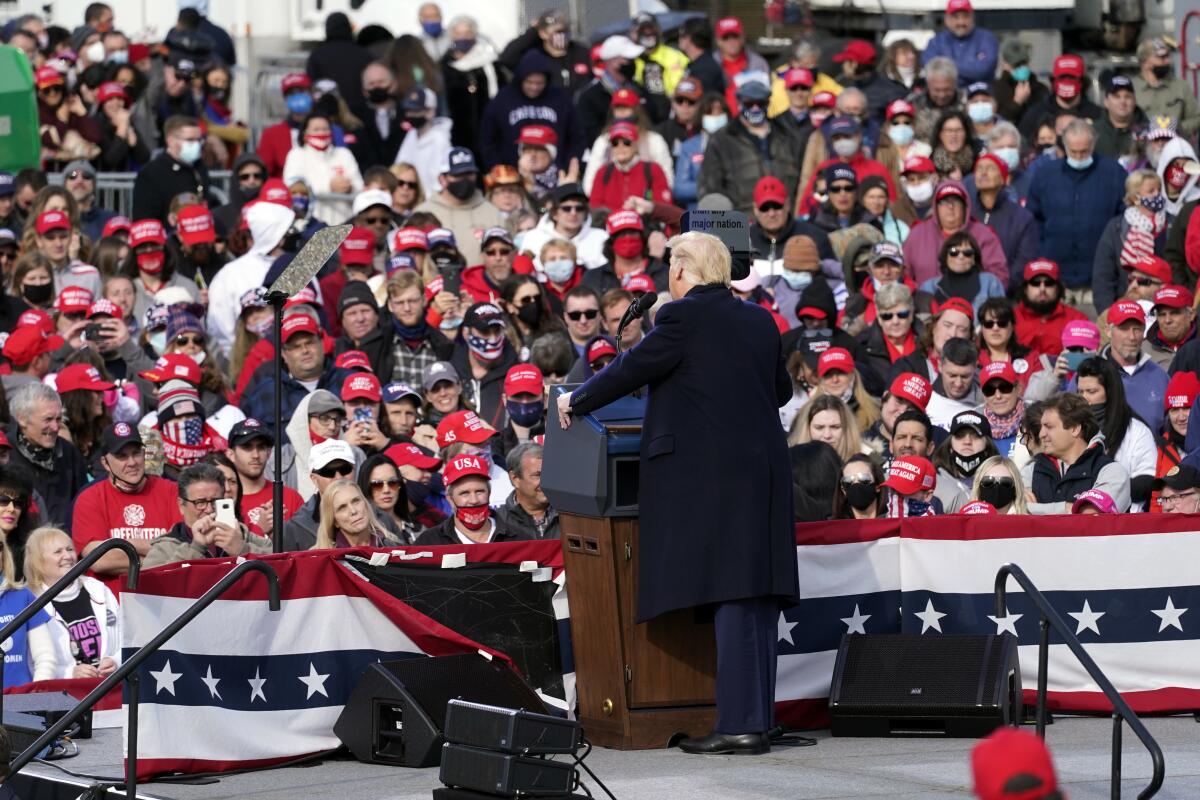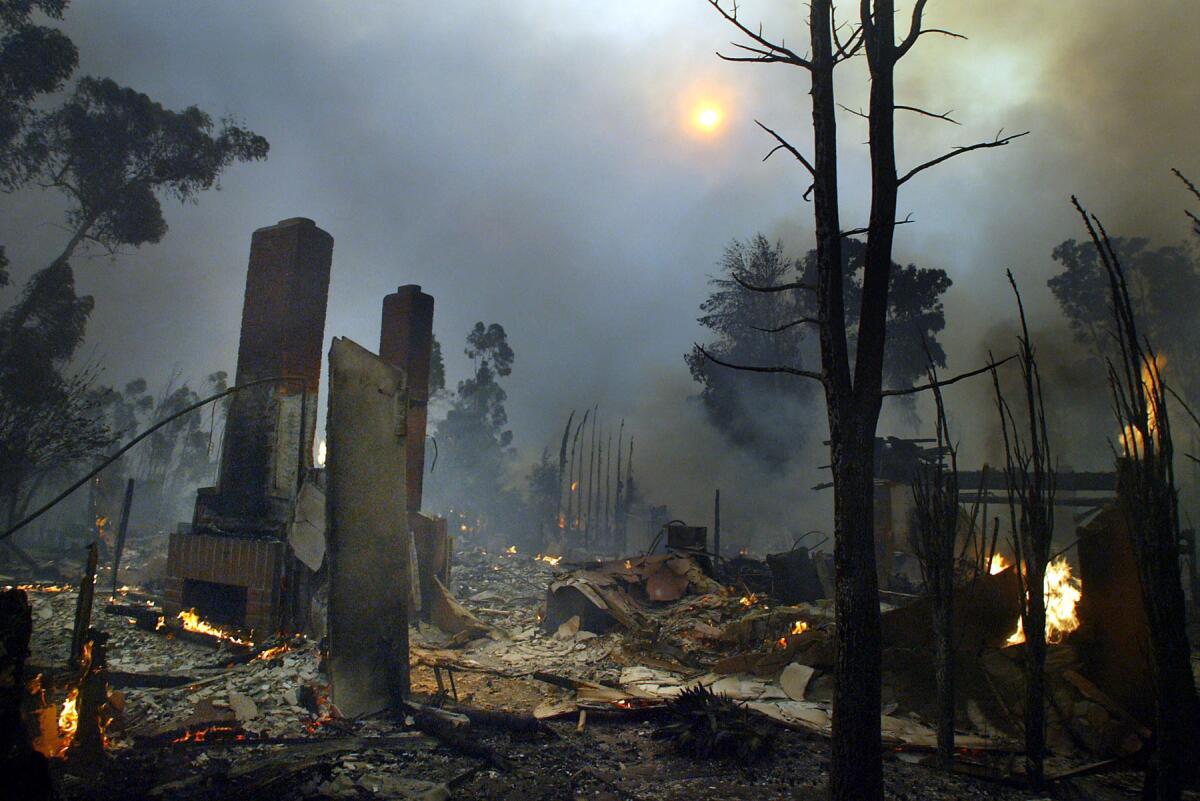Newsletter: Trump’s two adversaries

In the final days of the campaign, President Trump isn’t up against only Joe Biden.
TOP STORIES
Trump’s Two Adversaries
With early voting underway at a furious pace and with election day just over a week away, President Trump is fighting an uphill battle against two adversaries: Joe Biden and the COVID-19 pandemic.
Start your day right
Sign up for Essential California for the L.A. Times biggest news, features and recommendations in your inbox six days a week.
You may occasionally receive promotional content from the Los Angeles Times.
Trump’s repeated claim that the country has turned the corner on the coronavirus was undercut by news that members of Vice President Mike Pence’s inner circle had tested positive — and by Trump’s chief of staff Mark Meadows saying, “We’re not going to control the pandemic.”
Pence, who had headed Trump’s now-moribund coronavirus task force, did not quarantine but instead pressed on with campaign travel, as White House officials insisted it fell under an exemption from quarantine requirements granted to “essential workers” by the Centers for Disease Control and Prevention. Health policy experts question that.
The new outbreak and Meadows’ comments, set against the U.S. caseload and COVID-19 death toll setting records by the day, turned the spotlight back on the issue that voters see as the president’s biggest failure. It plays straight into the hands of Biden, who has laid out a detailed plan to fight the pandemic that has killed more than 225,000 people in the U.S.
More Politics
— Senate Republicans voted overwhelmingly to advance Supreme Court nominee Amy Coney Barrett toward final confirmation, likely today, despite Democratic objections. The vote was 51 to 48.
— Early voting is shattering records. Turnout may set a record too. And campaigns can’t keep up with demand for yard signs.
— North Carolina has been swamped with political ads — 7,000 in one day — more than any other state.
— How to vote in California: Our complete guide to making sure your ballot counts.
A Coronavirus Success Story
After cautiously approaching the pandemic for months, with a go-slow attitude toward reopening, San Francisco has become the first urban center in California to enter the least restrictive tier for reopening. The risk of infection, according to the state’s color-coded tiers, is considered minimal, even though San Francisco is the second-densest city in the country after New York.
In late April, San Francisco looked like a ghost town. Now, life has returned. Restaurants and stores are open, and last week, people strolled along the bay on the Embarcadero. A huge Ferris wheel opened for business at Golden Gate Park.
City officials still are not declaring victory, though. Characteristically, they warn, the virus still lurks around the corner. And as they have before, they will follow local metrics rather than reopen just because the state allows it. Here’s how they did it.
Dangerous Conditions Return
Forecasters say much of California will experience the most dangerous fire weather of the season as a weather system is expected to bring strong and dry winds through the state’s mountain passes.
In response to what’s known as Diablo winds in Northern California and Santa Ana winds in the southern part of the state, Pacific Gas and Electric began cutting power to nearly 1 million people in Northern and Central California on Sunday, and Los Angeles County emergency management officials sounded the alarm.
It represents an abrupt change from the cool, humid weather much of the state has experienced over the last week. In Southern California, the strong, gusty winds could also bring some big waves off the coast, the National Weather Service said.
A Dumping Ground Off Catalina
The pesticide DDT was once hailed as a major scientific achievement, before its deadly effects on birds and fish helped spark the environmental movement in the 1960s and its use was banned in the U.S. in 1972.
Using deep-sea robots, a new generation of scientists recently came across barrels filled with DDT-laced sludge in the waters off Catalina Island. As many as half a million of these barrels could still be underwater, according to interviews and a Times review of historical records, manifests and undigitized research.
How did they get there? Here is the largely unknown legacy of DDT in Los Angeles.
OUR MUST-READS FROM THE WEEKEND
— She’s pregnant, she has COVID-19, and she can’t breathe.
— When Americans go missing in Mexico, U.S. officials have to tell loved ones, “Go to Mexico.”
— Trump inspired these immigrants to become U.S. citizens and to vote. Against him, as columnist Gustavo Arellano writes.
— The official Halloween candy power rankings: What’s No. 1 in your bag?
FROM THE ARCHIVES
Early on the evening of Oct. 25, 2003, a novice deer hunter who had been lost for more than seven hours and was too weak from thirst to walk set two small signal fires in the Cleveland National Forest. Those erupted into the Cedar fire, which became what was then the largest blaze in California history, burning 273,000 acres, destroying more than 2,800 homes and killing 15 people in San Diego County.
“Twelve people died without warning in the early hours of Oct. 26 — burned in their cars, on foot and in their homes. A nurse died curled up in a bathtub with her Chihuahua. A teenager perished, refusing to flee until her mother returned home,” according to Times article that reconstructed what happened during the first 16 hours of the fire.
The Times’ coverage would go on to win the Pulitzer Prize. Sadly, the Cedar fire has been dwarfed by recent fires, including California’s first million-acre fire this year.

Want more of the Los Angeles Times archives? We’re on Instagram.
CALIFORNIA
— Several Los Angeles City Council members are pushing for a new law that would make it illegal for homeless people to set up camps near freeway overpasses and the city’s new temporary “bridge” shelters.
— Capt. Roy Nakamura, a 28-year veteran of the Arcadia Police Department, will become the first police chief of Japanese descent in a city where about 19,000 Japanese and Japanese Americans were temporarily incarcerated at the Santa Anita Park racetrack during World War II.
— Questions remain about a Woodland Hills woman found alive after going missing in Zion National Park.
— Rapper Offset was detained and a second man was arrested after police stopped their vehicle while they were driving past a pro-Trump rally in Beverly Hills.
Support our journalism
Subscribe to the Los Angeles Times.
NATION-WORLD
— Pope Francis named 13 new cardinals, including Washington, D.C., Archbishop Wilton Gregory, who will become the first Black U.S. prelate to earn the coveted red hat.
— Afghanistan claimed it killed a top Al Qaeda propagandist on an FBI most-wanted list during an operation in the country’s east, showing the militant group’s continued presence there, as U.S. forces work to withdraw from America’s longest-running war.
— Chileans voted overwhelmingly to rewrite the country’s constitution, which dates from the military dictatorship of Gen. Augusto Pinochet four decades ago.
— In Israel, ultra-Orthodox Jews are key allies of Prime Minister Benjamin Netanyahu. They’re also fueling the country’s big COVID-19 spike.
HOLLYWOOD AND THE ARTS
— Producer Jaime Dávila, the man behind the coming biographical saga “Selena: The Series,” is on a mission to get Hollywood’s gatekeepers to abandon their outdated perceptions of the Latinx market.
— Is there still hope for movie theaters? Former Times film critic Kenneth Turan thinks so, based on his eerie experience seeing “Tenet” in Montana.
— The Beach Boys — well, at least some of them — went from playing a Trump fundraiser to a drive-in concert at the Ventura County Fairgrounds.
— Here are five things to know about Maria Bakalova, the “Borat” star from that Rudy Giuliani scene in the new film.
BUSINESS
— An antitrust complaint against Google is the opening salvo in the battle to restrain Big Tech.
— The twin domes of the retired San Onofre nuclear plant will be coming down, but the process will be a massive undertaking over years.
SPORTS
— The Dodgers put the disastrous ending of Game 4 of the World Series behind them and beat the Tampa Bay Rays 4-2 in Game 5 on Sunday. The Dodgers are now one win away from winning their first World Series since 1988. Game 6 is Tuesday.
— The Chargers blew another big lead, but this time bounced back to beat the Jaguars.
Free online games
Get our free daily crossword puzzle, sudoku, word search and arcade games in our new game center at latimes.com/games.
OPINION
— Want to see what election fraud looks like? Look at Belarus, The Times’ editorial board writes.
— The seeds of California’s tattered economy were planted long before the coronavirus arrived, write Joel Kotkin and Marshall Toplansky.
WHAT OUR EDITORS ARE READING
— The FBI says a network of “Boogaloo Bois” may be coordinating acts of violence and terror. (BuzzFeed News)
— Officials in El Paso are asking residents to stay home for two weeks as COVID-19 hospitalizations surge. But they are encouraging people to vote. (Texas Tribune)
ONLY IN L.A.
After spending 24 years in the median of a run-of-the-mill strip mall at Santa Monica Boulevard and Vermont Avenue in East Hollywood, Sheila Klein’s beloved “Vermonica” light sculpture was moved without notice in 2017. Now, the installation made out of 25 vintage light poles has found a new home about a block away — and it’s been formally acquired by the city of L.A.
Comments or ideas? Email us at [email protected].
Sign up for Essential California
The most important California stories and recommendations in your inbox every morning.
You may occasionally receive promotional content from the Los Angeles Times.



